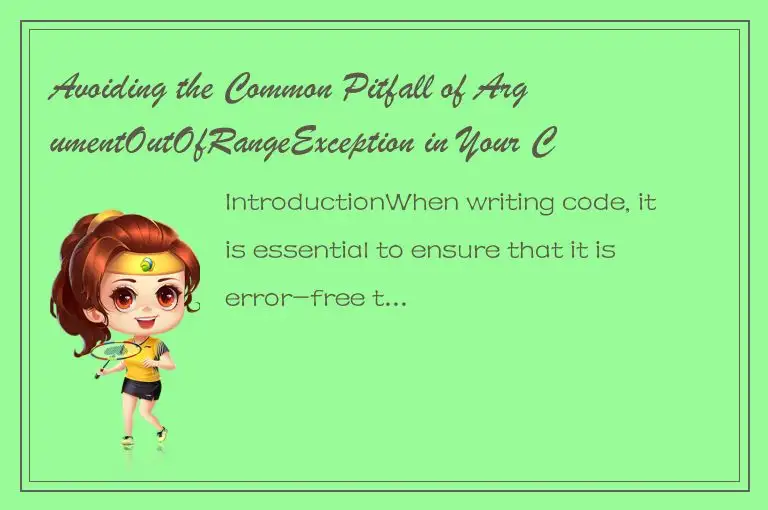Introduction

When writing code, it is essential to ensure that it is error-free to prevent runtime bugs and unexpected behavior. However, one common mistake among developers is overlooking the ArgumentOutOfRangeException exception that occurs when an argument value is outside an acceptable range. This exception is thrown when a method is passed a parameter that falls outside the valid range of values defined for it. In this article, we will explore the common pitfalls of ArgumentOutOfRangeException and provide some tips on how to avoid them.
Understanding the ArgumentOutOfRangeException Exception
The ArgumentOutOfRangeException exception occurs when a method is passed an argument that is not within the allowable range of values. For example, if a method expects an integer value between 1 and 10, and we pass in a value of 11, an ArgumentOutOfRangeException will be thrown.
Here is an example code block that illustrates how this exception can occur:
```csharp
public void PerformOperation(int value)
{
if (value < 1 || value > 10)
{
throw new ArgumentOutOfRangeException("Value must be between 1 and 10.");
}
// perform operation with value
}
```
In this code block, the PerformOperation method expects a parameter value that falls within the range of 1 to 10. However, if the passed-in value is less than 1 or greater than 10, the ArgumentOutOfRangeException is thrown.
Common Pitfalls of ArgumentOutOfRangeException
1. Not Validating User Input:
One common pitfall of ArgumentOutOfRangeException is failing to validate user input before calling a method. This error can occur when an application receives data from a user without validating it first. As a result, if a user submits an invalid value that falls outside of an expected range, an ArgumentOutOfRangeException exception will be thrown.
To avoid this problem, always ensure that user input is validated before calling a method. One way of doing this is by providing input validation routines before accepting user input.
2. Not Providing Adequate Error Messages:
Another pitfall of ArgumentOutOfRangeException is not providing adequate error messages. This pitfall occurs when an application does not provide clear and concise error messages that explain why the exception is thrown. Without a proper error message, a user may experience confusion in trying to understand the reason for the exception.
To avoid this pitfall, ensure to provide clear and concise error messages that explain the issue causing the ArgumentOutOfRangeException.
3. Incorrectly Specifying Range Limits:
Incorrectly specifying range limits for a method parameter can lead to an ArgumentOutOfRangeException. This error occurs when the implementation of the application has an incorrect definition of a parameter's allowable range. When this happens, the application creates confusion with users if the defined range is not explicit.
To avoid this pitfall, make sure to set strict range limits for all method parameters explicitly. The limits should be documented and be part of the API.
Best Practices for Avoiding ArgumentOutOfRangeException
1. Define Parameter Range Limits Explicitly:
When defining the limits of a method parameter range, ensure that they are defined explicitly. Define the range in the method's documentation and using meaningful parameter names.
For example, if you define a method that requires the parameter int age, make sure to define explicitly in the method's documentation the allowable range of ages.
```
///
/// The method performs a user registration based on the provided user details.
///
/// The user's age (must be between 18 and 65).
public void RegisterUser(int age)
{
if (age < 18 || age > 65)
throw new ArgumentOutOfRangeException("age", "Age must be between 18 and 65.");
}
```
2. Provide Adequate Error Messages:
To provide adequate error messages when an ArgumentOutOfRangeException exception is thrown, the application needs to determine the reason for the exception. Ensure the error message is specific to the reason for the exception and is clear and precise.
For example:
```
throw new ArgumentOutOfRangeException("age", $"User {userId} age must be between 18 and 65, but the value provided was {age}.")
```
3. Validate User Input:
An essential part of avoiding an ArgumentOutOfRangeException is validating user input. This step ensures that users do not enter invalid inputs, which could cause the exception to be thrown.
To validate, define well-documented input validation routines that are never skipped.
Conclusion
The ArgumentOutOfRangeException exception is a widespread error in application development that can lead to incorrect output or behavior. By using the best practices outlined in this article, you can avoid the common pitfalls of ArgumentOutOfRangeException and build robust, error-free code. Remember to define the range limits explicitly, provide adequate error messages, and validate user input to prevent mistakes.




 QQ客服专员
QQ客服专员 电话客服专员
电话客服专员